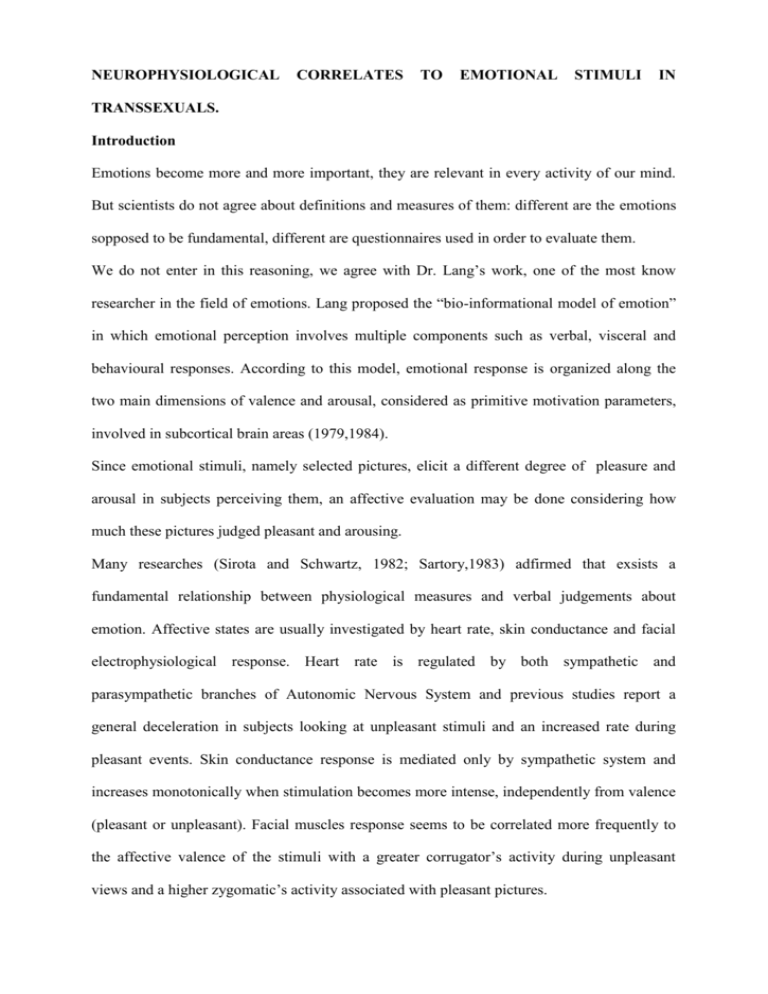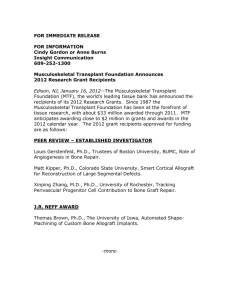
NEUROPHYSIOLOGICAL
CORRELATES
TO
EMOTIONAL
STIMULI
IN
TRANSSEXUALS.
Introduction
Emotions become more and more important, they are relevant in every activity of our mind.
But scientists do not agree about definitions and measures of them: different are the emotions
sopposed to be fundamental, different are questionnaires used in order to evaluate them.
We do not enter in this reasoning, we agree with Dr. Lang’s work, one of the most know
researcher in the field of emotions. Lang proposed the “bio-informational model of emotion”
in which emotional perception involves multiple components such as verbal, visceral and
behavioural responses. According to this model, emotional response is organized along the
two main dimensions of valence and arousal, considered as primitive motivation parameters,
involved in subcortical brain areas (1979,1984).
Since emotional stimuli, namely selected pictures, elicit a different degree of pleasure and
arousal in subjects perceiving them, an affective evaluation may be done considering how
much these pictures judged pleasant and arousing.
Many researches (Sirota and Schwartz, 1982; Sartory,1983) adfirmed that exsists a
fundamental relationship between physiological measures and verbal judgements about
emotion. Affective states are usually investigated by heart rate, skin conductance and facial
electrophysiological response. Heart rate is regulated by both sympathetic and
parasympathetic branches of Autonomic Nervous System and previous studies report a
general deceleration in subjects looking at unpleasant stimuli and an increased rate during
pleasant events. Skin conductance response is mediated only by sympathetic system and
increases monotonically when stimulation becomes more intense, independently from valence
(pleasant or unpleasant). Facial muscles response seems to be correlated more frequently to
the affective valence of the stimuli with a greater corrugator’s activity during unpleasant
views and a higher zygomatic’s activity associated with pleasant pictures.
Schwarts et al. (1980) found significant gender differences in affective response. In their work
women showed higher concordance between facial electromyographycal activity and stimulus
valence while men showed greater concordance between skin conductance and arousal. No
significant and clear gender differences were found (Siddle and Turpin, 1980). Greenwald et
al (1989) evidenced a greater zygomatic response in female for all levels of valence. This is in
agreement with the greater women’s ability to express emotion and with their richer social
communication.
There are little studies investigating the Nervous Autonomic System response during sexual
stimuli such as nudes pictures. Greenwald (1989) found an increase in skin conductance and
in both corrugator and zygomatic activity. No study is reported in literature about transsexual
psychophysiological response during affective stimuli presentation and in particular during
sexual stimuli consisting in female and male nudes.
The present study intends to examine the relationship between the affective valence of
different stimuli and facial electromyographical response in a group of transsexuals, with a
particular interest for data related to slides representing nudes.
Methods
Fourteen transsexuals [seven male to female (MtF); seven female to male (FtM)], some of
them in hormonal therapy, were enrolled in the study.
The control group consisted of fourteen subjects (seven men and seven women) not suffering
from Gender Identity Disorder and matched for age and educational level.
Sixty coloured pictures were chosen from the International Affective Picture System (IAPS),
a set of selected stimuli for experimental investigations of emotions and attention. These
pictures were split in three set: twenty negative, twenty positive and twenty neutral slides.
Pictures had been chosen for their affective impact (valence, arousal and dominance).
Subjects sat in an armchair, in a sound-attenuated and dimly lit room. The images were
projected 1,5 m from subject’s eyes. Each picture was presented for a period of six seconds,
followed by a blank screen for other 6 seconds. Each block of emotional stimuli (negative,
positive, neutral slides) was separated by the presentation of a blank screen for two minutes,
in order to avoid the effect of the stimuli summation.
The slides were presented using a Pentium III with 128 MB of RAM run by Windows NT
Workstation 4.0.
During the experimental session physiological signals (heart rate, skin conductance, facial
electromyographical activity) were recorded with a multichannel polygraph Galileo Sirius
Star Ebineuro.
Zygomatic and corrugator electromyographical activity were recorded bilaterally with
silver/silver miniature sensors. Signals were bandpass filtered from 100Hz open. Sensitivity
was 7mV. Artefacts were automatically rejected through a specific software.
Before the session we recorded a baseline data in order to standardise the acquisition of the
parameters.
In this study zygomatic and corrugator electromyographical activity was considered. Twenty
second of each slides set (negative, neutral, positive, nudes slides) were analysed.
Statistical analysis
First of all, raw scores for each subject were transformed in z scores. Both for zygomatic and
corrugator scores a mean of left and right activation was made. The Mann-Whitney test was
run to compare zygomatic and corrugator activity between groups. In order to evaluate
muscular activation as a function of different slides, the Wilcoxon test was performed on each
subgroups. A p value < .05 was considered as statically significant.
Results
Figure 1a/1b and 2a/2b showed zygomatic and corrugator activity in the control group (M and
F) and in the transsexual group (FtM and MtF).
The following comparisons were made to compare the different subgroups. Differences
statistically significant (p< .05) were pointed out. (ns= not significant).
CORRUGATOR
ZYGOMATIC
Male vs Female: ns
Male vs Female: ns
FtM vs MtF: positive slides (FtM > MtF)
FtM vs MtF: female nudes (FtM > MtF)
Male vs FtM: ns
Male vs FtM: ns
Female vs MtF: ns
Female vs MtF: ns
A further analysis was made in order to compare different slides activation in each subgroup:
CORRUGATOR
ZIGOMATIC
Negative vs neutral: ns
Negative vs Neutral : ns
Positive vs Neutral: male (positive < neutral), Positive vs Neutral: ns
MtF (positive <neutral)
Female nudes vs Neutral: FtM (female nudes >
Female nudes vs Neutral: male (female nudes < neutral)
neutral)
Male nude vs Neutral: male (male nudes <
neutral)
Male nudes vs Neutral: ns
MALE
corrugator
Zygomatic
1,00
Z-SCORES
0,50
0,46
0,44
0,02
-0,10
0,00
-0,11
-0,19
-0,11
-0,36-0,33
-0,50
-0,88
-1,00
NE
UT
RA
L
NE
GA
TIV
E
PO
SIT
FE
IVE
MA
L
MA
LE
EN
UD
ES
NU
DE
S
Fig. 1b
1,00
Zygomatic
0,51
0,48
0,50
Z-SCORES
corrugator
FEMALE
0,24
0,10
-0,01
0,00
-0,22
-0,27
-0,16
-0,48
-0,50
-0,82
-1,00
NE
UT
R
AL
NE
GA
T
IVE
PO
SIT
IVE
FE
MA
L
MA
LE
N
EN
UD
ES
UD
ES
Fig. 1a 1b: Corrugator and Zygomatic activity in Male and Female subjects
Fig. 2a
corrugator
FtM
Zygomatic
1,00
0,65
0,56
Z-SCORES
0,50
0,36
0,33
0,16
-0,09
0,00
-0,17
-0,31
-0,52
-0,50
-0,97
-1,00
NE
UT
R
NE
GA
T
AL
IVE
PO
SIT
FE
IVE
MA
LE
MA
L
EN
UD
ES
NU
DE
S
Fig. 2b
corrugator
MtF
Zygomatic
Z-SCORES
1,00
0,39
0,50
0,37
0,14
0,09
0,00
-0,26-0,21
-0,46
-0,34
-0,48
-0,50
-0,69
-1,00
NE
UT
RA
L
NE
GA
T
IVE
PO
SIT
FE
IVE
MA
L
MA
LE
EN
UD
ES
NU
DE
S
Fig. 2a 2b: Corrugator and Zygomatic activity in FtM and MtF transsexuals
Discussion
The most important result of our study was the evidence of a higher activity of the zygomatic
muscle in the FtM transsexuals respect to the MtF during the presentation of female nudes,
suggesting a real sexual attractive toward women. Moreover, heterosexual men showed a
significant decrease in the corrugator activity during positive and nudes stimuli (both female
and male) compared to neutral slides. MtF transsexuals showed a significant decrease in
corrugator activity at positive pictures respect to neutral ones. Finally, FtM group showed
higher zygomatic activity during the presentation of female nudes respect to neutral ones.
These data are in agreement with literature previously reported.
On the contrary, we didn’t obtain a significant difference between negative and positive
stimuli and women didn’t show an increase in zygomatic activity compared with men as
previously reported (Greenwald, 1989). Probably the exiguity of our sub-samples can explain
the discrepancies. However, if we consider the tendency of the facial muscles among the
positive, the negative and the neutral slides, we observe a higher activity of corrugator during
the negative pictures for all the groups with a general decrease during the positive slides. The
zygomatic response doesn’t evidence linear data.
The facial electromyographycal response at nude stimuli makes manifest patterns so
characteristic that allow us to discriminate men and FtM from women and MtF.
Control men showed a positive disposition toward nudes, in particular for female attractive
nudes with an increase in the zygomatic activity. Also FtM transsexuals seemed to be more
positively activated from women’s nudes than men’s nudes.
On the contrary, heterosexual women evidenced a higher zygomatic activity an a decrease in
corrugator activity for male nudes respect to female ones.
Finally, MtF transsexuals showed a tendency similar to control women: an increase in
zygomatic activity and a decrease in corrugator activity during male nudes and an inverse
pattern for female nudes.
Therefore, only men and FtM showed a zygomatic activity higher than corrugator activity
during female nudes. Women and MtF didn’t evidence the same tendency for male pictures,
suggesting a real sexual attractive toward women.
These data seem to confirm than men and FtM transsexuals are more capable in expressing
sexual attraction with involuntary behaviours. On the contrary, women and MtF transsexuals
appear more inhibited and sometimes disgusted viewing nudes in general. FtM transsexuals
and control men had similar reaction toward naked women: is it a sign of similar sexual
orientation, a real sexual attraction toward women? The differences between the sexes and
their homologous transsexuals can refer to social/cultural norms and to different cognitive and
affective styles, probably.
The results of this study are in agreement with an a previous research of ours about heart rate
evaluation in FtM and MtF transsexuals compared to a control group with the same pictures.
Also in that case, transsexuals showed a psychophysiological pattern similar to sex they felt to
belong.
References
Greenwald Mk, Cook EW, Lang PJ., Affective judgement and psychophysiological response:
dimensional covariation in the evaluation of pictorial stimuli, J Psychophysiology 1989, 5164.
Lang PJ., A bio-informational theory of emotional imagery, Psychophysiology 1979, 16:495512.
Lang PJ. (1984) Cognition in emotion: concept and action, In Izard CE, Kagan J, Zajonc RH
(Eds) Emotion, cognition and behaviour. New York: Cambridge University Press.
Perozzo P, Cappai E, Castelli L, Sassu O, Vighetti S, Molo M. La risposta emozionale a
stimoli visivi a contenuto erotico in soggetti transessuali, .n: Barbaro Verde J, Genazzani AR,
(Eds) Identità sessuale: percorsi a confronto. CIC, 2002 Roma.
Sartory G (1983) The orienting response and psychopathology: anxiety and phobias, in:
Siddle D (Eds) Orienting and habituation: perspectives in human research: Chichester: Wiley.
Schwartz GE, Brown S, Ahern G. Facial muscle pattering and subjective experience during
affective imagery: sex differences: Psychophysiology 1980, 17:75-82.
Siddle D, Turpin G. (1980) Measurement, quantification and analysis of cardiac activity. In:
Martin I, Venable PH (Eds) Techniques in psychophysiology. NY: Wiley
Sirota AD, Schwartz GE. Facial muscle pattering and lateralization during elation and
depression imagery: J Abnormal Psychology 1982, 91:25-34.







